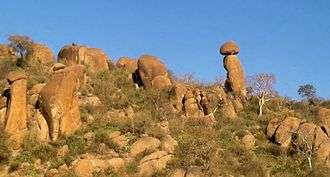Babille, Oromia (woreda)
Babille is one of the woredas in the Oromia Region of Ethiopia. It is named after one of the 12 major tribes of the Oromo people, the Babille Oromo. Part of the East Hararghe Zone, Babille is bordered on the south and east by the Somali Region, on the west by Fedis, and on the north by Gursum; the Fafen River defines a portion of Babille's eastern border. The administrative center of this woreda is Babille.
Overview

The altitude of this woreda ranges from 950 to 2000 meters above sea level; Ambelber and Sarbadin are amongst the highest points. Rivers include the Daketa, Barale, and Erer Tiko. A survey of the land in this woreda (reported in 1995/96) shows that 21.1% is arable or cultivable (17.5% was under annual crops), 3.9% pasture, 3.7% forest, and the remaining 71.3% is considered built-up, degraded or otherwise unusable. Much of Babille is occupied by the Harar Wildlife Sanctuary. The "Valley of Marvels" (a rock formation near the village of Dakata)[1] and the Erer sanctuary are local landmarks. Oil seeds and groundnuts are important cash crops.[2]
Industry in the woreda includes 10 grain mills and one metalworking industry employing 39 people, as well as 160 registered businesses including wholesalers, retailers and service providers; although no mines are active, feldspar and garnet deposits are known to exist. There were 14 Farmers Associations with 7529 members and one Farmers Service Cooperative with 26 members. Babille has 54 kilometers of rural feeder and 29 of all-weather road, for an average road density of 16.2 kilometers per 1000 square kilometers.[2] Until recently, about 41.5% of the population have access to drinking water, but on 12 December 2007 woreda officials announced the completion of a program to improve access to drinking water, constructing wells in 17 rural kebeles at a cost of 1.1 million Birr, which extended coverage to about 48.5% of the population.[3]
Demographics
The 2007 national census reported a total population for this woreda of 93,708, of whom 47,178 were men and 46,530 were women; 17,712 or 18.9% of its population were urban dwellers. The majority of the inhabitants said they were Muslim, with 95.71% of the population reporting they observed this belief, while 3.4% of the population practised Ethiopian Orthodox Christianity.[4]
Based on figures published by the Central Statistical Agency in 2005, this woreda has an estimated total population of 72,791, of whom 35,912 are men and 36,879 are women; 16,454 or 22.60% of its population are urban dwellers, which is greater than the Zone average of 6.9%. With an estimated area of 5,120.63 square kilometers, Babille has an estimated population density of 14.2 people per square kilometer, which is less than the Zone average of 102.6.[5]
The 1994 national census reported a total population for this woreda of 50,204, of whom 25,419 were men and 24,785 women; 9,195 or 18.32% of its population were urban dwellers at the time. (This total also includes an estimate for the inhabitants of several rural kebeles, which were not counted; they were estimated to have 2,134 inhabitants, of whom 1,116 were men and 1,018 women.) The three largest ethnic groups reported in Babille were the Somali (10.77%), the Oromo (85.77%), and the Amhara (3.76%); all other ethnic groups made up 1.03% of the population. Somali was spoken as a first language by 9.76%, 84.97% spoke Oromofita, and 4.58% spoke Amharic; the remaining 0.69% spoke all other primary languages reported. The majority of the inhabitants were Muslim, with 98.89% of the population having reported they practiced that belief, while 2.84% of the population said they professed Ethiopian Orthodox Christianity.[6]
Notes
- The valley is described in Philip Briggs, Ethiopia: The Bradt Travel Guide, 3rd edition (Chalfont St Peters: Bradt, 2002), pp. 366f
- Socio-economic profile of the East Hararghe Zone Government of Oromia Region (last accessed 1 August 2006).
- "Potable water projects benefiting over 7,500 inhabitants go operational in woreda" (Walta Information Center)
- 2007 Population and Housing Census of Ethiopia: Results for Oromia Region, Vol. 1 Archived November 13, 2011, at the Wayback Machine, Tables 2.1, 2.5, 3.4 (accessed 13 January 2012)
- CSA 2005 National Statistics Archived November 23, 2006, at the Wayback Machine, Tables B.3 and B.4
- 1994 Population and Housing Census of Ethiopia: Results for Oromia Region, Vol. 1, part 1 Archived November 15, 2009, at the Wayback Machine, Tables 2.1, 2.13, 2.16, 2.20 (accessed 6 April 2009)